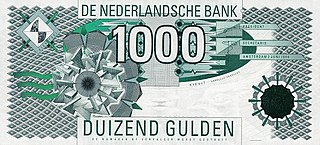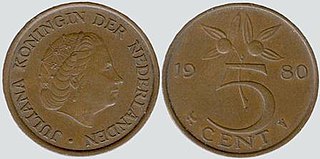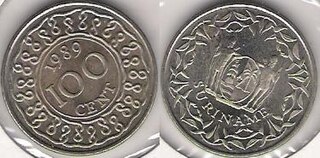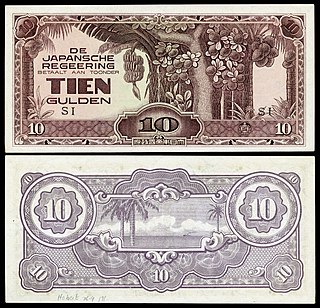
The Belgian franc was the currency of the Kingdom of Belgium from 1832 until 2002 when the Euro was introduced. It was subdivided into 100 subunits, each known as a centiem in Dutch, or centime in French and German.

The guilder or florin was the currency of the Netherlands from 1434 until 2002, when it was replaced by the euro.

The stuiver was a coin used in the Netherlands, worth 1⁄20 Dutch Guilders. It was also minted on the Lower Rhine region and the Dutch colonies. The word can still refer to the 5 euro cent coin, which has almost exactly the same diameter and colour despite being over twice the value of the older coin.

The Netherlands Antillean guilder is the currency of Curaçao and Sint Maarten, which until 2010 formed the Netherlands Antilles along with Bonaire, Saba, and Sint Eustatius. It is subdivided into 100 cents. The guilder was replaced on 1 January 2011 on the islands of Bonaire, Saba and Sint Eustatius by the United States dollar.

The rijksdaalder was a Dutch coin first issued by the Republic of the Seven United Netherlands in the late 16th century during the Dutch Revolt which featured an armored half bust of William the Silent. It was the Dutch counterpart of the Reichsthaler of the Holy Roman Empire but weighed slightly less, at 29.03 g of 0.885 fine silver, reduced to 0.875 fine by the 17th century. Friesland, Gelderland, Holland, Kampen, Overijssel, Utrecht, West Friesland, Zeeland, and Zwolle minted armored half bust rijksdaalders until the end of the 17th century.

The guilder was the currency of Suriname until 2004, when it was replaced by the Surinamese dollar. It was divided into 100 cents. Until the 1940s, the plural in Dutch was cents, with centen appearing on some early paper money, but after the 1940s the Dutch plural became cent.

The Netherlands Indies guilder, later the Netherlands Indies roepiah, was the currency issued by the Japanese occupiers in the Dutch East Indies between 1942 and 1945. It was subdivided into 100 sen and replaced the guilder at par.

The 25-cent piece was the highest-denomination coin minted in the Netherlands during World War II. Struck between 1941 and 1943, the 25-cent coin was worth 1⁄4, or 0.25, of a Dutch guilder. It was made entirely of zinc, and designed by Nico de Haas, a Dutch national-socialist. The respective mintage was of 34,600,000 (1941), (1942), 13,600,000 (1943).

The zinc 10-cent coin was minted in the Netherlands between 1941 and 1943 during World War II. It was worth 1/10, or .10, of the guilder, and designed by Nico de Haas, a Dutch national-socialist. The respective mintage was of 29,800,000 (1941), 95,600,000 (1942), 29,000,000 (1943).
The One guilder coin was a coin struck in the Kingdom of the Netherlands between 1818 and 2001. It remained in circulation until 2002 when the guilder currency was replaced by the euro. No guilder coins were minted in the German occupation of the Netherlands in World War II.

The zinc 5-cent coin was minted in the Netherlands between 1941 and 1943 during World War II. It was worth 1/20, or .05, of the guilder, and designed by Nico de Haas, a Dutch national-socialist.

The twenty-five cent was a coin worth a quarter of decimal Dutch guilder. It was used from the decimalisation of the currency in 1817 until the Netherlands adopted the euro as sole currency in 2002. The last minting was in 2001. The coin was the third-smallest denomination of the guilder when the currency was withdrawn, and the largest of a value less than one guilder.

The 2+1⁄2-cent coin minted in the Netherlands during World War II was made of zinc, and worth 1⁄40, or .025, of the Dutch guilder. It was designed by Nico de Haas, a Dutch national-socialist, and struck in 1941 and 1942.

A dubbeltje is a small former Dutch coin, originally made of silver, with a value of a tenth of a Dutch guilder. The 10-euro-cent coin is currently also called a dubbeltje in the Netherlands.

The Five cent coin was a coin struck in the Kingdom of the Netherlands between 1818 and 2001. Twenty stuivers equalled a Dutch Guilder.
The Half guilder coin was a silver coin struck in the Kingdom of the Netherlands between 1818 and 1930. The obverse featured a portrait of the Dutch reigning King or Queen. On the reverse was a crowned Dutch coat of arms between the value. All coins were minted in Utrecht except the year 1829 and 1830 that were minted in Brussels.
The Two and a half cent coin was struck in the Kingdom of the Netherlands between 1818 and 1942. All coins were minted in Utrecht.

The one-cent coin was a coin struck in the Kingdom of the Netherlands between 1817 and 1980. The coin was worth 1 cent or 1⁄100 of a Dutch guilder.
The Three guilder coin was a silver coin struck in the Kingdom of the Netherlands between 1817 and 1832.

Although the vast majority of coins are round, coins are made in a variety of other shapes, including squares, diamonds, hexagons, heptagons, octagons, decagons, and dodecagons. They have also been struck with scalloped (wavy) edges, and with holes in the middle. Coins in the shape of polygons often have rounded edges or are Reuleaux polygons.
















